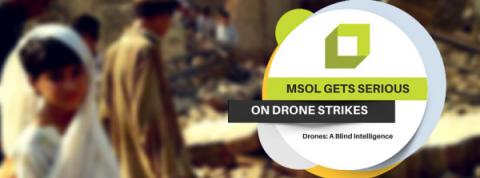Drones: A Blind Intelligence
Jun 23,2015
In the novel Ender’s Game, children are selected to train for an interstellar war using simulations in the form of games. The idea of the game allows players to make riskier decisions because of disconnection from reality. Casualties do not matter as long as the ultimate goal of decimating a pixelated enemy is met. Little do the characters know, the simulation is real, and they successfully drive an entire race to extinction. Orson Scott Card wrote this novel in 1985, but in 2002 his idea of dehumanized conflict became real as the CIA launched the first modern Predator drone strike near Khost, Afghanistan (Sifton, 2012). Like Ender’s Game, drones objectify the target. Human beings become voiceless, neon monsters on a motion-tracking camera to an aerial sniper behind a computer screen. This is the reality of drone warfare. Drones are a silent killer that causes unrest in communities and tarnishes the American presence in the Middle East. They are said to be safer for troops because an unmanned aircraft saves lives from combat fatalities, but their use increases distrust and hostility to those serving on the ground. With every unintentional casualty, terrorist organizations such as ISIL gain fuel to lure traumatized populations into joining their cause. By using drones, the U.S. also opens the gate for further violations of international humanitarian law by countries like Russia, creating a new arms race (Boyle, 2013, p. 22). By using armed drone technology, the military willingly adopts terrorist tactics. The U.S. government has crossed the line from War on Terror to War of Terror.
Drone strikes give terrorist organizations free advertisement for recruits, encourage anti-Americanism, and cause social unrest in bombing zones. The amount of civilian deaths released by the U.S. government is often underestimated because the U.S. “records all military-age males in a strike zone as ‘militants’ unless clear evidence to the contrary emerges after the attack” (Boyle, 2013, p.7). This raises problems because it assumes culpability on possible victims and evidence proving the innocence of a person killed by a strike is almost never investigated or may have been destroyed in the attack. The Columbia Human Rights Clinic “found 2300 percent more ‘civilian’ deaths than the New America Foundation and 140 percent more ‘civilian’ deaths than the Long War Journal” for the airstrikes for Pakistan in 2011 (Shah, n.d.). The exact number of civilian casualties is difficult to map but the common consensus is that there the U.S. needs to accept more accountability for the destruction of these assaults. Proponents of drone strikes claim that unmanned crafts reduce the risk of soldier casualties, but the growing hostility towards the U.S. due to drone tactics create a hazardous environment for soldiers stationed in civilian areas and increases the threat of domestic terrorism. Mistrust in the military increases as the anxiety from unexpected airstrikes inhibits the daily life of civilians. The cultures of regions being affected, such as Syria, Yemen, and Somalia, rely heavily on familial and social connections. Locals are now imprisoned in their own homes with fear of a sudden assault. Economic activity often comes to a standstill following a bombing, and children are pulled from schools. Paid informants place “small electronic targeting devices in the homes or vehicles of suspected terrorists. Yet there is no way to tell whether these chips are left with real terrorist operatives or with those against whom the informant has a personal grudge” (Boyle, 2013, p. 21). Angered civilians who witness or experience these events are more likely to unite against the United States. The Arabian Peninsula saw a direct correlation between drone activity and an increased number of al-Qaeda members with the end of the seven-year hiatus of U.S. airstrikes in 2009 (ProCon.org, 2014). In Yemen, Author Jeremy Scahill claims the majority of militants are “people who are aggrieved by attacks on their homes that forced them to go out and fight” (ProCon.org, 2014). The threat of retribution for strikes in the Middle East reaches home as seen in the failed Times Square bombing and the Underwear Bomber (ProCon.org, 2014). Bomber Faisal Shahzad is quoted as saying, “the drone hits in Afghanistan and Iraq, they don’t see children, they don’t see anybody” in reply to the judge asking how he could knowingly kill innocents (Boyle, 2013, p. 1).
Airstrikes violate international humanitarian law. “Article 6.1 of the International Covenant on Civil and Political Rights, a multilateral treaty adopted by the United Nations, states that ‘no one shall be arbitrarily deprived of his life,’ even in times of armed conflict” (ProCon.org, 2014). This means that every loss of civilian life is deliberate violation of Article 6.1. The American usage of drones also gives other countries excuses to violate human rights. The U.S. dictates that these attacks are warranted because of the War on Terror. Since the term “terrorist” is subjective, other countries can justify brutality against non-combatants using the same explanation. “China could justify drone strikes against Tibetan separatists in India, Russia could justify attacks against rebels in Chechnya, or Turkey could target Kurdish insurgents in Iraq” in the name of a War on Terror (ProCon.org, 2014). Proponents argue that Article 51 of the United Nations charter allows for the use of drones in the name of self-defense, which is what the U.S. is currently using as justification but members of militant groups that are not in conflict with the U.S. are not considered lawful targets (ProCon.org, 2014). The automatic labeling of killed military-aged males as militants also breaches international law by “presuming that they are guilty by association” and violating “the principle of non-combatant immunity” (Boyle, 2013, p. 7).
The mental strain on drone crewmen is vastly underestimated. Surveys show that as many as 61% of Americans support drone warfare and proponents suggest that aerial snipers run a lesser risk of post-traumatic stress disorder (ProCon.org, 2014). A quote by Heather Linebaugh, a former drone imagery analyst, begs to differ, “How many women and children have you seen incinerated by a Hellfire missile? How many men have you seen crawl across a field, trying to make it to the nearest compound for help while bleeding out from severed legs?” (Chatterjee, 2015). Many pilots have stated that being forced to watch images and footage of war has started “inducing an unprecedented, long-distance version of post-traumatic stress syndrome” (Chatterjee, 2015). “I felt like I was haunted by a legion of the dead. My physical health was gone, my mental health was crumbled. I was in so much pain I was ready to eat a bullet myself.” one soldier was quoted as saying in regards to his experiences with post-traumatic stress disorder (Chatterjee, 2015). The stress on drone crews may not be relatable to soldiers stationed over-seas, but the long hours, mental affects of guilt, and psychological desensitization of watching horrific images has caused a recent surge of operators to quit in record numbers (Chatterjee, 2015). A decrease in the workforce has placed increased pressure on current crew that make up only half of what is needed. Despite logging anywhere from two to six times the amount of hours than the average Air Force pilot, the average outlook of drone pilots are dismal due to the lack of respect that they receive compared to other Air Force personnel (Chatterjee, 2015).
The United States Military’s usage of drones creates a mockery of the essential American values of sovereignty and freedom. By blindly bombing civilian populated regions, the government paints itself as a figure of brutality that unintentionally encourages retaliation in the form of domestic terrorist attacks. The continual breach of international humanitarian law is allowing other nations to follow and will essentially render the law useless because of the subjective meaning associated with it. Despite the American stance on terrorism, countries affected by airstrikes now view U.S. drone tactics as acts of terrorism. The U.S. is a world power that once stood for freedom and justice but now, due to drone usage, it now stands as a monolith of unchecked brutality that has become what it had originally set out to defeat in the War on Terror.
References Shaw, N. (n.d). Counting Drone Strike Deaths. Retrieved fromhttp://web.law.columbia.edu/human-rights-institute/counterterrorism/drone-strikes/counting-drone-strike-deaths ProCon.org (2014, August 11). Should the United States Continue Its Use of Drone Strikes Abroad?. Retrieved from http://drones.procon.org/ Robinson, R. (2013, October 31). The Downside of Drones. Retrieved fromhttp://www.usnews.com/opinion/blogs/world-report/2013/10/31/drone-strikes-arent-always-the-most-effective-counterterrorism-measure Pitch Interactive. (2015). [Graphic illustration of drone strikes in Pakistan since 2004]. Out of Sight, Out of Mind. Retrieved from http://drones.pitchinteractive.com/ Boyle, M. (2013). The Costs and Consequences of Drone Warfare. International Affairs, 89(1), 1-29. Retrieved from http://libproxy.uhcl.edu:2093/stable/i23473509 Valdes, R. (2004, April 1) How the Predator UAV Works. Retrieved fromhttp://science.howstuffworks.com/predator.htm NOVA. (n.d.). What Drones Can See?. Retrieved fromhttp://www.thirteen.org/programs/nova/what-drones-can-see/ Sifton, J. (2012) A Brief History of Drones. The Nation, (February 27, 2012). Retrieved fromhttp://www.thenation.com/article/166124/brief-history-drones Chatterjee, P., (2015, March 5) American Drone Operators Are Quitting in Record Numbers. Retrieved from http://www.thenation.com/article/200337/american-drone-operators-are-quitting-record-numbers U.S. Air Force., (2010, February 21). Transcripts of U.S. Drone Attack. Retrieved fromhttp://documents.latimes.com/transcript-of-drone-attack/





